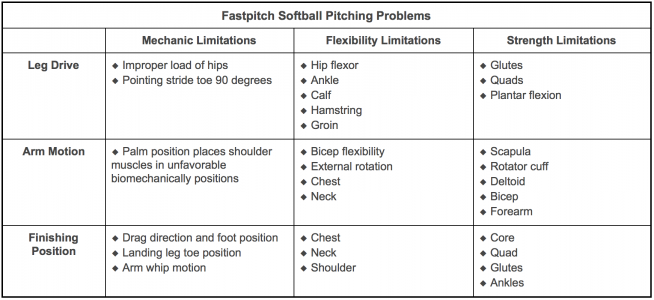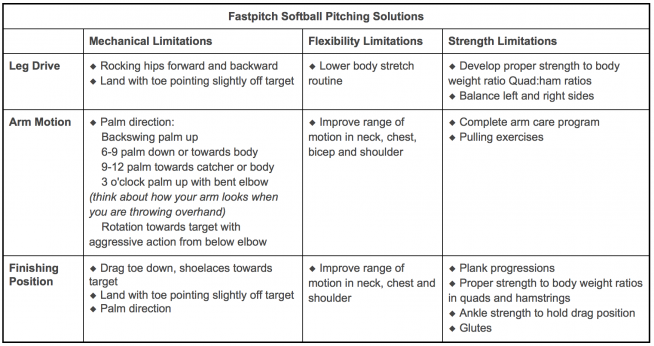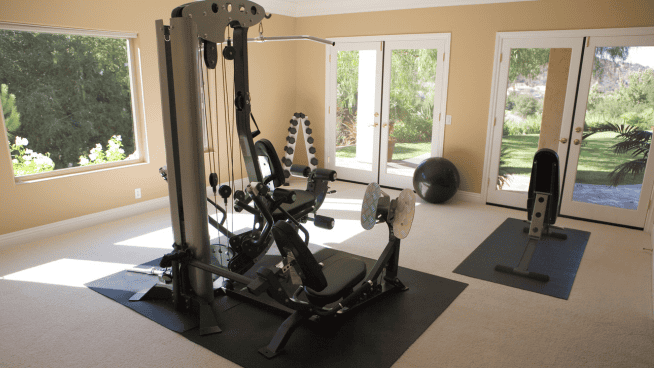How to Fix 3 Common Softball Pitching Mistakes
The complex motion for fastpitch softball pitching has many moving parts with many common issues and even more ideas on how to fix them.
This guide will address the leg drive, aspects of the arm motion and characteristics of the finishing position. Most problems have easy solutions while other problems are caused by the physical limitations of the athlete.
- Leg drive includes everything from the push until the landing. The big question is how to improve leg drive to generate more speed?
- The arm motion is obviously important when accuracy is concerned. How to keep the windmill in line? How to open shoulders? How to improve accuracy in fastpitch softball pitching?
- Finishing position questions come in a variety of forms. How to release the ball? How to fix leaning? How to fix drag?
Simply identifying the problems and making pitchers aware does not work for the majority of players. From coaching experience, I believe the majority are trying to fix issues and searching for information to make themselves better. If they do not correct their motion after becoming aware, there are three possible limitations preventing them from making necessary adjustments.
1. Mechanical limitations
Mechanical limits are developed because of improper actions due to a lack of efficient movements.
2. Flexibility limitations
A lack of flexibility is not easy for the average coach to diagnose. All athletes should be encouraged to increase total body flexibility. Pitchers can benefit the most from extra flexibility in the hips and shoulders.
3. Strength limitations
There are a number of athletes who experience strength limitations due to an underdeveloped strength-to-bodyweight ratio. Muscles move bones, and bones have to be moved to perform the correct pitching motion. If a pitcher does not have a proper strength-to-bodyweight ratio, you will see various problems that cannot be improved upon with normal pitching practice.
The following charts show the most common problems in the fastpitch softball pitching motion broken down into mechanical, flexibility and strength limitations.
Fastpitch softball pitching assessments provide a full report on an athletes limitations and custom plan to improve the individual as an athlete and pitcher.
KaselowGraphics/iStockPhotos
RECOMMENDED FOR YOU
How to Fix 3 Common Softball Pitching Mistakes
The complex motion for fastpitch softball pitching has many moving parts with many common issues and even more ideas on how to fix them.
This guide will address the leg drive, aspects of the arm motion and characteristics of the finishing position. Most problems have easy solutions while other problems are caused by the physical limitations of the athlete.
- Leg drive includes everything from the push until the landing. The big question is how to improve leg drive to generate more speed?
- The arm motion is obviously important when accuracy is concerned. How to keep the windmill in line? How to open shoulders? How to improve accuracy in fastpitch softball pitching?
- Finishing position questions come in a variety of forms. How to release the ball? How to fix leaning? How to fix drag?
Simply identifying the problems and making pitchers aware does not work for the majority of players. From coaching experience, I believe the majority are trying to fix issues and searching for information to make themselves better. If they do not correct their motion after becoming aware, there are three possible limitations preventing them from making necessary adjustments.
1. Mechanical limitations
Mechanical limits are developed because of improper actions due to a lack of efficient movements.
2. Flexibility limitations
A lack of flexibility is not easy for the average coach to diagnose. All athletes should be encouraged to increase total body flexibility. Pitchers can benefit the most from extra flexibility in the hips and shoulders.
3. Strength limitations
There are a number of athletes who experience strength limitations due to an underdeveloped strength-to-bodyweight ratio. Muscles move bones, and bones have to be moved to perform the correct pitching motion. If a pitcher does not have a proper strength-to-bodyweight ratio, you will see various problems that cannot be improved upon with normal pitching practice.
The following charts show the most common problems in the fastpitch softball pitching motion broken down into mechanical, flexibility and strength limitations.
Fastpitch softball pitching assessments provide a full report on an athletes limitations and custom plan to improve the individual as an athlete and pitcher.
KaselowGraphics/iStockPhotos













